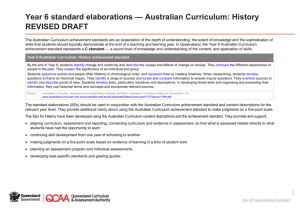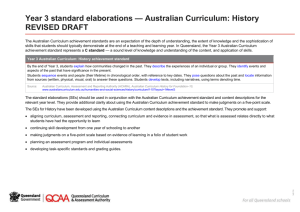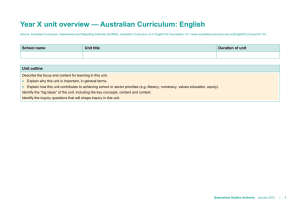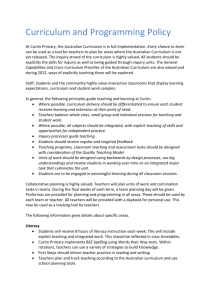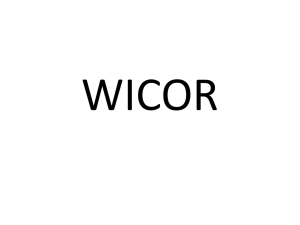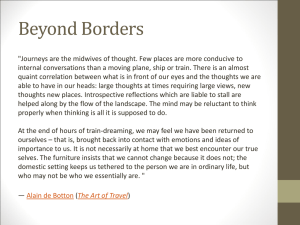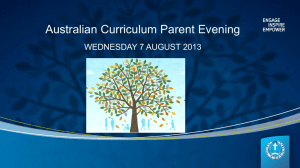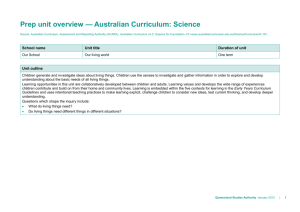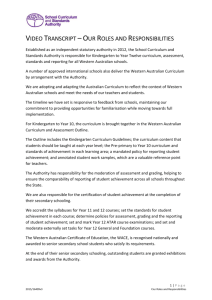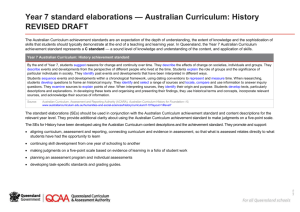Year 5 History standard elaborations
advertisement
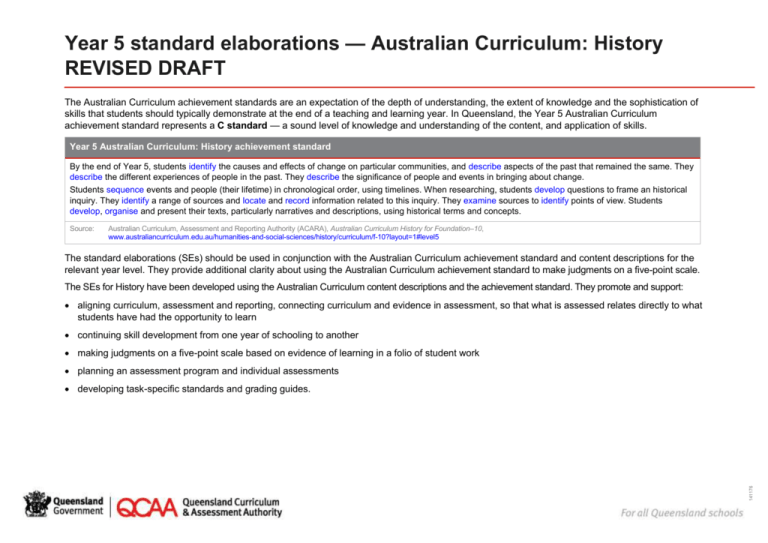
Year 5 standard elaborations — Australian Curriculum: History REVISED DRAFT The Australian Curriculum achievement standards are an expectation of the depth of understanding, the extent of knowledge and the sophistication of skills that students should typically demonstrate at the end of a teaching and learning year. In Queensland, the Year 5 Australian Curriculum achievement standard represents a C standard — a sound level of knowledge and understanding of the content, and application of skills. Year 5 Australian Curriculum: History achievement standard By the end of Year 5, students identify the causes and effects of change on particular communities, and describe aspects of the past that remained the same. They describe the different experiences of people in the past. They describe the significance of people and events in bringing about change. Students sequence events and people (their lifetime) in chronological order, using timelines. When researching, students develop questions to frame an historical inquiry. They identify a range of sources and locate and record information related to this inquiry. They examine sources to identify points of view. Students develop, organise and present their texts, particularly narratives and descriptions, using historical terms and concepts. Source: Australian Curriculum, Assessment and Reporting Authority (ACARA), Australian Curriculum History for Foundation–10, www.australiancurriculum.edu.au/humanities-and-social-sciences/history/curriculum/f-10?layout=1#level5 The standard elaborations (SEs) should be used in conjunction with the Australian Curriculum achievement standard and content descriptions for the relevant year level. They provide additional clarity about using the Australian Curriculum achievement standard to make judgments on a five-point scale. The SEs for History have been developed using the Australian Curriculum content descriptions and the achievement standard. They promote and support: aligning curriculum, assessment and reporting, connecting curriculum and evidence in assessment, so that what is assessed relates directly to what students have had the opportunity to learn continuing skill development from one year of schooling to another making judgments on a five-point scale based on evidence of learning in a folio of student work planning an assessment program and individual assessments 141176 developing task-specific standards and grading guides. Year 5 History standard elaborations A REVISED DRAFT B C D E Historical knowledge and understanding Questioning and researching Analysing and interpreting Understanding and skills dimensions The folio of student work has the following characteristics: identification and explanation of the causes and effects of change on particular communities and comprehensive description of aspects of the past that have remained the same identification and description of the causes and effects of change on particular communities and detailed description of aspects of the past that have remained the same identification of the causes and effects of change on particular communities and description of aspects of the past that have remained the same identification of aspects of the causes and effects of change on particular communities and identification of aspects of the past that have remained the same statements about the causes and effects of change on communities and aspects of the past comprehensive description of: different experiences of people in the past the significance of people and events in bringing about change detailed description of: description of: description of aspects of: statements about: different experiences of different experiences of different experiences of different experiences of people in the past the significance of people and events in bringing about change people in the past the significance of people and events in bringing about change people in the past the significance of people and events in bringing about change development of questions to frame an historical inquiry and identification of a range of sources and location, recording and considered use of information to effectively answer these questions development of questions to frame an historical inquiry and identification of a range of sources and location, recording and informed use of information to effectively answer these questions development of questions to frame an historical inquiry and identification of a range of sources and location, recording and use of information related to this inquiry development of questions that relate to historical inquiry and identification of sources and recording of information related to aspects of this inquiry use of questions and recording of information examination of sources to identify and explain points of view examination of sources to identify and describe points of view examination of sources to identify points of view examination of sources to identify aspects of points of view identification of aspects of points of view Year 5 standard elaborations — Australian Curriculum: History REVISED DRAFT people in the past people and events and change Queensland Curriculum & Assessment Authority February 2015 Page 2 of 6 A B C D E Key Communicating Understanding and skills dimensions The folio of student work has the following characteristics: accurate and detailed sequencing of events and people’s lifetimes in chronological order using timelines detailed sequencing of events and people’s lifetimes in chronological order using timelines sequencing of events and people’s lifetimes in chronological order using timelines partial sequencing of events and people’s lifetimes in chronological order using timelines listing of events and people’s lifetimes development, organisation and purposeful presentation of texts, including narratives and descriptions using relevant historical terms and concepts development, organisation and effective presentation of texts, including narratives and descriptions using relevant historical terms and concepts development, organisation and presentation of texts, including narratives and descriptions using historical terms and concepts development, organisation and partial presentation of texts including narratives and descriptions using everyday language fragmented presentation of texts including narratives and descriptions using everyday language Shading emphasises the key aspects of the achievement standard and qualities that discriminate between the A–E descriptors. Key terms are described overleaf. Year 5 standard elaborations — Australian Curriculum: History REVISED DRAFT Queensland Curriculum & Assessment Authority February 2015 Page 3 of 6 Notes Australian Curriculum common dimensions The SEs describe the qualities of achievement in the two dimensions common to all Australian Curriculum learning area achievement standards — understanding and skills. Dimension Description understanding the concepts underpinning and connecting knowledge in a learning area, related to a student’s ability to appropriately select and apply knowledge to solve problems in that learning area skills the specific techniques, strategies and processes in a learning area Terms used in Year 5 History SEs The following terms are used in the Year 5 History SEs. They help to clarify the descriptors, and should be read in conjunction with the ACARA History glossary: www.australiancurriculum.edu.au/humanities-and-social-sciences/history/Glossary. Term Description accurate consistent with a standard, rule, convention or known facts aspects particular parts or features cause and effect a relationship in which one event (the cause) makes another event happen (the effect), one cause can have several effects; in History, used to identify chains of events and developments over time, both short term and long term change events or developments from the past that represent modifications, alterations and transformations comprehensive detailed and thorough, including all that is relevant concepts; historical concepts an abstract idea or notion; in History, a historical concept refers to any general notion or idea that is used to develop an understanding of the past, such as concepts related to the process of historical inquiry (e.g. evidence, continuity and change, perspectives, significance) and concepts that are culturally significant to Aboriginal and Torres Strait Islander peoples (e.g. country and place) description; describe give an account of characteristics or features detailed meticulous; including many of the parts development; develop elaborate or expand in detail; to create or construct effective; effectively meeting the assigned purpose in a way that produces a desired or intended result examination; examine determine the nature of conditions of Year 5 standard elaborations — Australian Curriculum: History REVISED DRAFT Queensland Curriculum & Assessment Authority February 2015 Page 4 of 6 Term Description explanation; explain provide additional information that demonstrates understanding of reasoning and/or application fragmented disjointed, incomplete or isolated historical inquiry the process of investigation undertaken in order to understand the past; steps in the inquiry process include posing questions, locating and analysing sources and using evidence from sources to develop an informed explanation about the past historical terms words or phrases used to describe abstract aspects or features of the past (e.g. colonisation, revolution, imperialism, democracy) and more specific features (e.g. pyramid, gladiator, temple, rock shelter) identification; identify establish or indicate who or what someone or something is, includes recognition information knowledge communicated or received concerning some fact or circumstance list; listing a record consisting of a series of names, words, or the like; a number of names of persons or things set down one after another location; locate act or process of finding or obtaining, usually in reference to research or working with information sources narrative a text that makes sense of the past based on a selection of a sequence of events; a text that compares the past with the present to determine change; narrative texts include stories and recounts organisation; organise to form as or into a whole consisting of a sequence or interdependent parts partial attempted; incomplete evidence provided particular relating to some one person, thing, group, class, occasion, etc., rather than to others or all point of view way of regarding situations, events, facts and people; a person’s perspective, the position from which they see and understand particular events presentation an address or report on a particular topic, especially one supported by images, digital data, exhibits, etc. purposeful intentional; done by design; focused and clearly linked to the goals of the task range covers the scope of relevant situations or elements relevant applicable and pertinent sequence; sequencing arrange in a definite order; in History, sequencing includes chronological order significance importance, of consequence; in History, the importance assigned to particular aspects of the past, (e.g. events, developments, movements, historical sites) source any written or non-written materials that can be used to investigate the past; a source becomes evidence if it is of value to a particular inquiry statement a sentence or assertion Year 5 standard elaborations — Australian Curriculum: History REVISED DRAFT Queensland Curriculum & Assessment Authority February 2015 Page 5 of 6 Term Description text; texts the means for communication; their forms and conventions have developed to help us communicate effectively with a variety of audiences for a range of purposes; texts can be written, spoken or multimodal and in print or digital/online forms; multimodal texts combine language with other systems for communication, such as print text, visual images, soundtrack and spoken word as in film or computer presentation media use of to operate or put into effect Year 5 standard elaborations — Australian Curriculum: History REVISED DRAFT Queensland Curriculum & Assessment Authority February 2015 Page 6 of 6
